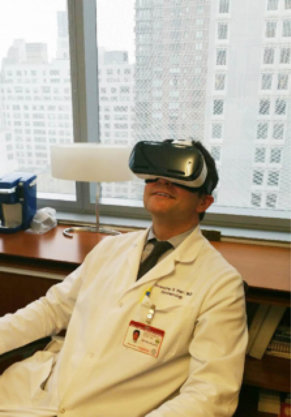Virtual reality (VR) is undeniably the hot technology this year. While VR has existed in some forms for decades, only recently have sensor and display technology advanced enough to allow the development of commercially viable VR head-mounted displays. Using high-accuracy head tracking, powerful graphics processors, and high-resolution displays, these devices surround the user with three-dimensional imagery and sound, allowing the user to feel transported to another location.
December 2014 saw the release of the Oculus and Samsung Gear VR device, which uses a mobile phone to provide the only commercially available VR system thus far. Oculus has previously released two headset kits for developers to use, but no wide commercial release is yet imminent. Valve, a gaming company, and HTC recently announced their collaboration on the Vive head-mounted VR display, which will use high-accuracy laser tracking to provide even smoother and more realistic motion tracking.
VR IN MEDICINE
Although recently the focus of VR technology has been on its potential for entertainment and gaming, which is admittedly great, there will also undoubtedly be many applications of this technology in medicine. There has already been a study published on the use of the Oculus Rift VR system for pain reduction in pediatric burn patients.1

The VR device is comfortable for physicians to use.
In a recent study, now under peer review, we used the Samsung Gear VR headset to display high-resolution Optos widefield retinal photography. This, for the first time, places the ophthalmologist virtually inside an eye and allows for close observation of retinal pathology. The virtual retina is displayed an order of magnitude larger and has much less distortion than that possible on a computer screen. Our results showed equal accuracy in diagnosis using the VR display as compared with a traditional computer display in 10 different cases.2 However, we speculate that as technologies such as adaptive optics generate images of the eye in more detail, such a VR display may prove to be the ideal method of efficiently displaying high-resolution ocular imagery and could be used in the clinic and in research.
This demonstrates one use of VR in ophthalmology, but it’s easy to imagine many more uses of such powerful technology in other areas of medicine. VR could provide a new level of awareness and interactivity for telemedicine, allow for better display and diagnosis in radiology, and even provide virtual mobility for the disabled or bed-bound.
SAFETY
As ophthalmologists, we need also think of the safety of VR devices. There have been reports of what has been termed simulation sickness for the uncomfortable effects VR can have on the body. As of yet, there have been no studies on the effects of placing such powerful displays within inches of the eye for extended periods of time. Such studies will be of great interest as VR technology comes to wide commercial release and millions of users, including children, begin to adopt the technology for entertainment and gaming.
SUMMARY
The potential for VR in health care is huge. We are optimistic about the improvements it can bring to medicine but also encourage further study on its safety. We hope that this discussion will stimulate ideas on how to apply VR technology to improve patient care.
1. Hoffman HG, Meyer WJ 3rd, Ramirez M, et al. Feasibility of articulated arm mounted Oculus Rift Virtual Reality goggles for adjunctive pain control during occupational therapy in pediatric burn patients. Cyberpsychol Behav Soc Netw. 2014;17(6):397-401.
2. Zheng LL, He LM, Yu CQ. Mobile virtual reality for ophthalmic image display and diagnosis. Submitted for publication.
